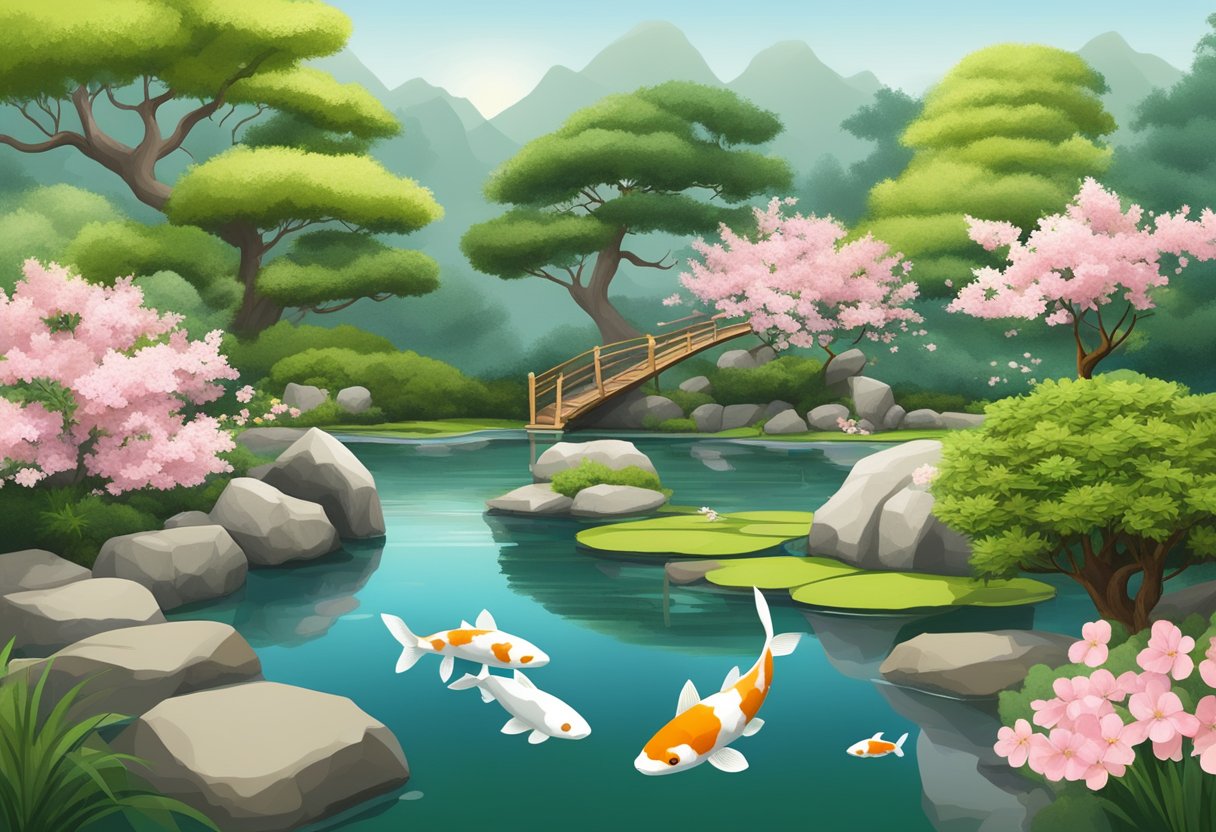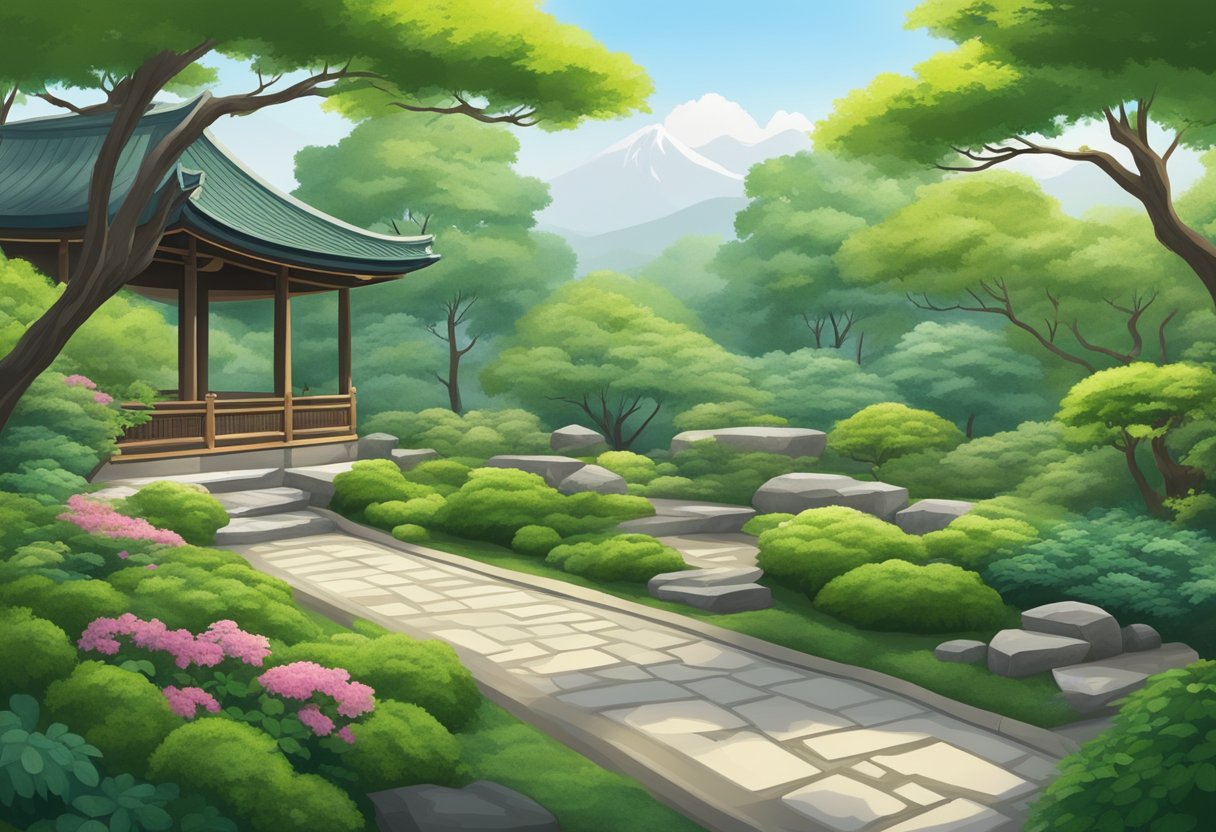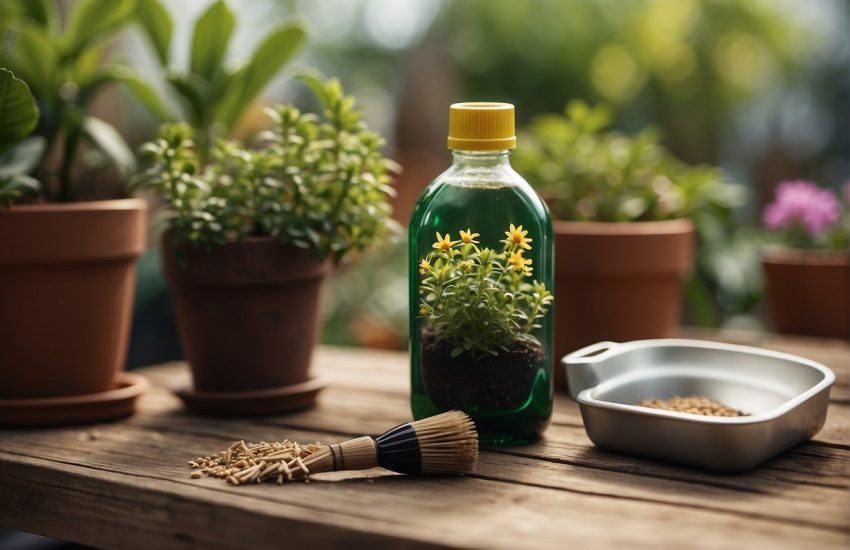Plants for Japanese Garden: Choosing the Right Flora for Your Tranquil Space
Japanese gardens are known for their serenity, tranquility, and beauty. One of the essential elements of a Japanese garden is the use of plants that reflect the natural beauty of the landscape. The careful selection and placement of plants in a Japanese garden are crucial to creating a harmonious and balanced design.

Japanese garden design is rooted in the traditional principles of Japanese culture, which emphasizes simplicity, balance, and harmony with nature. The use of plants in a Japanese garden is not just for decorative purposes but also to create a sense of tranquility and peace. The plants are carefully chosen to complement each other and the surrounding landscape, creating a cohesive and integrated design. The goal is to create a space that is both beautiful and restful, where visitors can feel a sense of calm and connection with nature.
Understanding Japanese Garden Design
Japanese gardens are known for their serene and calming atmosphere that promotes meditation and reflection. These gardens have been around for centuries and have evolved to become an important part of Japanese culture. In this section, we will explore the history, design principles, and elements of tranquility that make up the Japanese garden.
History and Philosophy
The origins of Japanese gardens can be traced back to the Asuka period (538-710 CE) when the Japanese began to adopt Chinese culture and religion. Buddhist monks brought with them the concept of creating gardens as a way to meditate and connect with nature. Over time, Japanese gardens evolved to become an expression of Japanese philosophy and aesthetics.
The philosophy behind Japanese gardens is rooted in Zen Buddhism, which emphasizes simplicity, mindfulness, and harmony with nature. The design of Japanese gardens reflects this philosophy by creating a space that is simple, yet elegant, and that blends with the natural surroundings.
Design Principles
There are several design principles that are essential to creating a Japanese garden. These principles include simplicity, asymmetry, and the use of natural materials.
Simplicity is achieved by using a limited number of elements and creating a sense of balance and harmony between them. Asymmetry is used to create a sense of movement and flow within the garden. Natural materials such as stone, gravel, and wood are used to create a sense of harmony with the natural surroundings.
Elements of Tranquility
The elements of tranquility are what make Japanese gardens so unique and special. These elements include water, rocks, plants, and ornaments.
Water is an essential element of Japanese gardens and is often used to create a sense of calm and tranquility. Rocks are used to create a sense of stability and permanence. Plants are used to add color and texture to the garden, while ornaments such as lanterns and statues are used to create focal points and add interest.
In conclusion, Japanese gardens are a reflection of Japanese philosophy and aesthetics. They are designed to create a serene and calming atmosphere that promotes meditation and reflection. By understanding the history, design principles, and elements of tranquility that make up Japanese gardens, one can appreciate the beauty and significance of these gardens.
Selecting Plants for Japanese Gardens
When it comes to selecting plants for Japanese gardens, it’s important to consider the overall aesthetic and symbolism of the garden. Japanese gardens are known for their tranquility, simplicity, and balance, and the plants chosen should reflect these qualities. Here are a few things to keep in mind when selecting plants for a Japanese garden.
Trees and Their Significance
Trees are an essential element of Japanese gardens and are often used to represent the passage of time and the changing of the seasons. One of the most popular trees for Japanese gardens is the Japanese maple (Acer palmatum), which is valued for its delicate foliage and vibrant fall colors. Other popular trees include cherry blossoms (sakura), pine trees (matsu), and Japanese black pines (kuro-matsu).
Shrubs and Bamboo
Shrubs and bamboo are also important components of Japanese gardens. Shrubs such as camellias, azaleas, and boxwoods can be used to create hedges or to add color and texture to the garden. Bamboo, on the other hand, is valued for its flexibility and strength, and is often used to create fences, trellises, and other structures.
Flowering Plants and Perennials
Flowering plants and perennials can add color and texture to a Japanese garden, and are often used to create focal points or to highlight certain areas of the garden. Some popular choices include irises, lotus flowers, and Japanese anemones. It’s important to choose plants that are well-suited to the climate and soil conditions of the garden.
Overall, when selecting plants for a Japanese garden, it’s important to keep the overall aesthetic and symbolism of the garden in mind. By choosing plants that reflect the tranquility, simplicity, and balance of a traditional Japanese garden, you can create a beautiful and harmonious space that will be enjoyed for years to come.
Color in the Japanese Garden

The Role of Color
Color plays a significant role in the Japanese garden, where it is used to create an atmosphere of tranquility and harmony. One of the most important aspects of color in the Japanese garden is its ability to evoke emotions and create a sense of calm.
Red, pink, and white are often used in the Japanese garden to create a sense of serenity and peace. These colors are associated with purity, innocence, and tranquility. Blue is also used to create a calming effect, representing the sky and water.
In contrast, orange is used to create a sense of excitement and energy in the garden. The bright color is often used to draw attention to specific areas or elements of the garden.
Green leaves are a staple in the Japanese garden, representing growth, renewal, and nature. The color is used to create a sense of balance and harmony in the garden, providing a calming effect that complements other bolder colors.
Creating Seasonal Interest
In addition to creating a peaceful atmosphere, color is also used in the Japanese garden to create seasonal interest. Crimson and scarlet leaves in the fall are a popular sight in the Japanese garden, creating a sense of warmth and coziness.
Fall colors are also used to complement other elements in the garden, such as rocks and water features. The changing colors of the leaves can be used to create a sense of movement and flow in the garden, adding to its overall tranquility.
Overall, color is an essential element in the Japanese garden, used to create a sense of harmony and tranquility. Whether it’s the calming effect of green leaves or the excitement of bright orange, color plays a vital role in creating a beautiful and peaceful garden.
Structural Elements and Water Features

Rocks and Sand
Rocks and sand are essential elements in a Japanese garden. They serve as the foundation for the garden’s design and provide a sense of structure and balance. Rocks are often used to create a sense of stability and permanence, while sand is used to represent water and create a calming effect.
In a Japanese garden, rocks are carefully selected and placed to create a natural and harmonious landscape. They are often arranged in groups of three, five, or seven, with the tallest rock in the center and the smaller rocks surrounding it. This arrangement is known as “mitsu-gumi” and is meant to represent heaven, earth, and humanity.
Sand, on the other hand, is used to create the illusion of water. It is raked into patterns that represent ripples and waves, and is often used in conjunction with rocks to create a sense of a dry riverbed. This technique is known as “kare-sansui” or dry landscape.
Water as a Central Element
Water is a central element in Japanese garden design. It represents life, purity, and renewal, and is often used to create a sense of tranquility and calm. Ponds and water features are common in Japanese gardens, and are often home to lotus flowers, which are symbolic of purity and enlightenment.
In a Japanese garden, water is often used to create a sense of movement and flow. It is often incorporated into the landscape in the form of a stream or waterfall, which can be used to create a sense of movement and sound. Water features are often placed near seating areas, allowing visitors to enjoy the soothing sound of running water.
Overall, the use of structural elements and water features in a Japanese garden is essential to creating a sense of harmony and balance. The careful placement of rocks and sand, and the incorporation of water into the landscape, can create a peaceful and tranquil space that is both beautiful and functional.
Cultivating a Japanese Garden

Creating a Japanese garden requires careful consideration of plant selection and placement to achieve a harmonious and peaceful atmosphere. The following subsections will cover plant care and maintenance as well as adapting to the climate when cultivating a Japanese garden.
Plant Care and Maintenance
Proper plant care is essential to maintaining the beauty and health of a Japanese garden. Regular watering and fertilization are necessary to ensure healthy growth and vibrant colors. It is important to monitor moisture levels in the soil and adjust watering accordingly, as overwatering can lead to root rot and other issues.
Pruning and trimming are also crucial to maintaining the desired shape and size of plants in a Japanese garden. Shearing and shaping techniques are often used to create the distinctive look of Japanese gardens, and regular maintenance is necessary to keep plants looking their best.
Adapting to Climate
When selecting plants for a Japanese garden, it is important to consider the local climate and growing conditions. Many traditional Japanese garden plants are native to Japan and may not thrive in other regions. However, there are many hardy plants that can be adapted to a variety of climates and growing conditions.
Partial shade and filtered light are ideal for many Japanese garden plants, as direct sunlight can be too intense. Location is also important, as plants should be placed in areas that provide adequate drainage and protection from strong winds.
In North America, there are many plants that are well-suited for Japanese gardens, including Japanese maple trees, azaleas, and bamboo. These plants are hardy and adaptable, making them ideal for a variety of climates and growing conditions.
Overall, cultivating a Japanese garden requires careful planning and attention to detail. With proper plant care and adaptation to the local climate, a beautiful and serene Japanese garden can be created in any location.
Popular Plants in Japanese Gardens

Japanese gardens are known for their serene beauty and attention to detail. One of the key elements that make these gardens so special is the use of carefully chosen plants. In this section, we will take a look at some of the most popular plants used in Japanese gardens.
Maples and Pines
Japanese maple and pine trees are two of the most iconic plants found in Japanese gardens. Their striking foliage and unique shapes make them ideal for creating a sense of tranquility and harmony. Japanese maples come in a variety of colors, including red, green, and yellow, and their leaves can be either palmate or lace-like. Pine trees, on the other hand, are known for their distinctive needles and cones.
Azaleas and Rhododendrons
Azaleas and rhododendrons are two flowering shrubs that are commonly found in Japanese gardens. These plants produce large, showy blooms in a range of colors, from white and pink to red and purple. Azaleas and rhododendrons are often planted in mass groupings to create a dramatic burst of color.
Irises and Lilies
Irises and lilies are two water-loving plants that are often found in Japanese water gardens. Japanese irises have large, showy flowers in shades of blue, purple, and white, while lilies come in a variety of colors, including pink, yellow, and white. These plants are often used to create a sense of tranquility and calm around water features such as ponds and streams.
In conclusion, these are just a few of the many plants that are commonly found in Japanese gardens. Whether you are looking to create a peaceful retreat in your own backyard or simply appreciate the beauty of these plants, incorporating them into your landscape design is sure to bring a sense of serenity and harmony to your space.
Special Features and Plant Varieties

Unique Plant Characteristics
Japanese gardens are known for their unique and eye-catching plant varieties. One such plant is the Hakonechloa macra, also known as the Hakone grass. This groundcover is prized for its glossy foliage and arching clusters, which make it a popular addition to Japanese gardens. Another popular plant is the ornamental cherry tree, which produces stunning white flowers in the spring.
Azaleas, hostas, hydrangeas, and rhododendrons are also commonly found in Japanese gardens. These plants are chosen for their fragrant flowers and rosette-like foliage. The Japanese quince is another popular plant, with its single or double flowers in shades of pink, red, and white.
Rare and Dwarf Varieties
In addition to the more common plant varieties, Japanese gardens often feature rare and dwarf cultivars. One example is the dwarf quince, which produces small, fragrant flowers and is ideal for small gardens or bonsai trees. The Hakone grass also has a dwarf variety, which is perfect for adding texture and interest to small spaces.
For those looking for evergreen shrubs, the evergreen conifer is a popular choice. With its lobed leaves and variegated foliage, this plant adds year-round interest to any garden. The Japanese forest grass is another evergreen option, with its delicate leaves and eye-catching texture.
Overall, Japanese gardens offer a wide variety of plant options, from groundcovers to towering trees. By carefully selecting plants with unique characteristics, gardeners can create a beautiful and tranquil space that is perfect for relaxation and meditation.
Incorporating Non-Plant Elements

Japanese gardens are known for their minimalist design and careful selection of plants. However, incorporating non-plant elements such as stones, gravel, garden ornaments, and bridges can add depth and interest to a garden without sacrificing its simplicity.
Stones and Gravel
Stones and gravel are essential elements in Japanese gardens. They can be used to create pathways, define borders, or add texture to a garden. In Japanese culture, stones are believed to have spiritual qualities and are often used to represent mountains or islands.
When selecting stones for a Japanese garden, it’s important to choose ones that are natural-looking and have interesting shapes and textures. Flat stones can be used to create stepping stones or to line a pathway, while larger boulders can be used as focal points.
Gravel is another important element in Japanese gardens, and is often used to create dry riverbeds or to cover the ground around plants. When selecting gravel, it’s important to choose a type that is appropriate for the size of the garden and the plants that will be growing in it.
Garden Ornaments and Bridges
Garden ornaments and bridges can add a touch of whimsy and charm to a Japanese garden. Lanterns, pagodas, and statues are popular choices, and can be used to create a focal point or to add interest to a corner of the garden.
Bridges are another popular element in Japanese gardens, and can be used to span a pond or stream, or to create a pathway over a dry riverbed. When selecting a bridge, it’s important to choose one that is in proportion to the size of the garden and is made from natural materials such as wood or stone.
Incorporating non-plant elements into a Japanese garden can be a great way to add interest and depth to a small space. By carefully selecting stones, gravel, garden ornaments, and bridges, it’s possible to create a garden that reflects the beauty and simplicity of Japanese culture.
Frequently Asked Questions

What are the top plant choices to create an authentic Japanese garden atmosphere?
When it comes to creating an authentic Japanese garden atmosphere, there are a few plant choices that are commonly used. These include Japanese maples, cherry blossoms, bamboo, pine trees, and azaleas. These plants are known for their beauty and ability to create a serene and peaceful environment.
Which low maintenance plants are suitable for a Japanese garden setting?
Low maintenance plants are ideal for a Japanese garden setting as they require minimal care and attention. Some examples of low maintenance plants that are suitable for a Japanese garden include ferns, hostas, moss, and ornamental grasses. These plants can add texture and interest to your garden without requiring a lot of upkeep.
What are some perennial plants that can thrive in a Japanese garden?
Perennial plants are a great choice for a Japanese garden as they come back year after year and require minimal care. Some popular perennial plants that can thrive in a Japanese garden include Japanese iris, astilbe, daylilies, and Japanese anemones. These plants can add color and texture to your garden and are known for their ability to thrive in a variety of conditions.
Can you suggest some dwarf shrubs that are ideal for Japanese garden aesthetics?
Dwarf shrubs are a great choice for a Japanese garden as they add structure and interest without taking up too much space. Some ideal dwarf shrubs for Japanese garden aesthetics include boxwood, Japanese holly, and dwarf Japanese garden juniper. These plants are known for their compact size and ability to thrive in a variety of conditions.
What plant options are available for a Japanese garden in full sun conditions?
If you have a Japanese garden in full sun conditions, there are a few plant options that are well-suited to this environment. These include Japanese black pine, Japanese wisteria, and Japanese blood grass. These plants are known for their ability to thrive in full sun conditions and can add color and interest to your garden.
How can I design a Japanese garden in a small space while maintaining its traditional elements?
Designing a Japanese garden in a small space can be challenging, but it is possible to maintain its traditional elements. Some tips for designing a Japanese garden in a small space include using small-scale plants, incorporating water features, and creating a sense of depth with rocks and pathways. By keeping things simple and focusing on key elements, you can create a beautiful and authentic Japanese garden in a small space.


